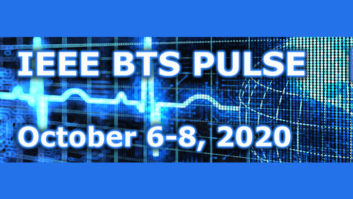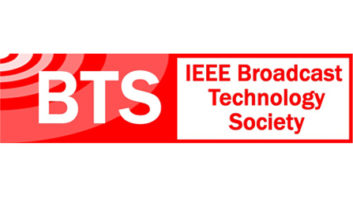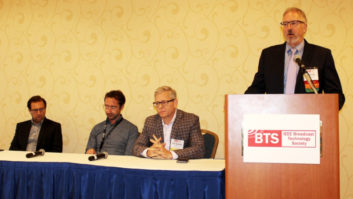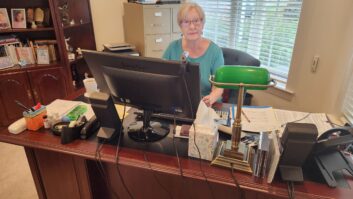Following four years of being on a pandemic-driven “hold,” the IEEE Broadcast Technology Society’s Fall Symposium resumed, with a return to its original Washington, D.C., home. The presentations took place at the new headquarters of the National Association of Broadcasters.
The November event attracted attendees from broadcast engineering, equipment manufacturing and academic sectors, and featured a variety of presentations on both technological advances and problems common to broadcasters.
COMPRESSION ARTIFACTS: ARE THEY SOMETHING TO WORRY ABOUT?
With compression technology now commonplace in transporting broadcaster’s FM multiplexes from studio to transmitter, Worldcast Systems’ Tony Peterle became curious about possible signal degradation, and this was the topic of his presentation.
Peterle said that while the focus of his testing was really on “what actually reaches a listener’s ears,” it included measurements of frequency response, distortion and stereo separation. He credited engineers Paul Shulins and Shane Toven for their assistance with the project.
The testing involved a representative sample of codecs, including units from 2WCom, APT, GatesAir, Omnia and Thimeo Audio Technology.
Peterle initially ran a “baseline” test without a codec, followed by runs with the various codecs and data rates. Speech, music and PPM information were all part of the testing.
Tests showed some amount of high frequency roll-off, along with slightly increased distortion, with some variations observed among units under test. Stereo separation was generally acceptable.
Peterle did report inconsistencies, though, especially with PPM measurements, saying that in some cases, confidence scores were higher with compression than without.
“You can run the same signal through an encoder five times and you get five different results,” said Peterle. “There’s no consistency. More work needs to be done.”
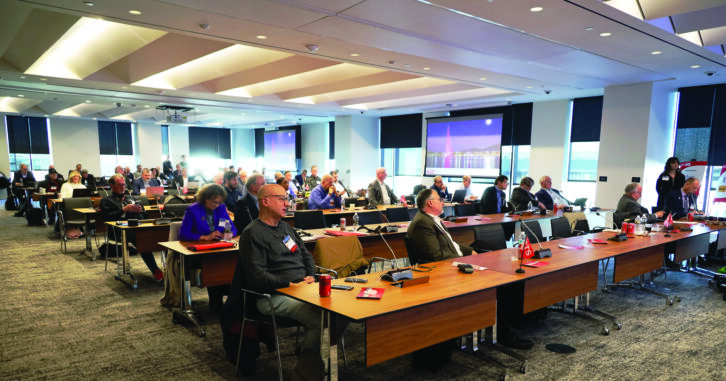
KEEPING BROADCAST SYSTEMS AND CONTENT SECURE
In the “good old days,” the only thievery broadcasters worried about was in losing their top-rated DJ to a competing station or record albums disappearing during overnight shifts.
Now thievery can take place from half a world away with a computer and a few key clicks. Educational Media Foundation’s Shane Toven provided pointers on keeping what’s yours out of the reach of hackers in his presentation “Common-sense Cybersecurity for Broadcasters.”
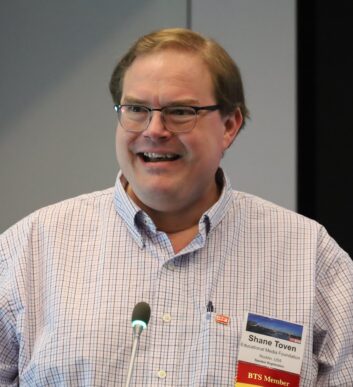
Toven noted that such intrusions not only result in lost revenue and payment of ransoms to cyber thieves, but can also result in financial and legal penalties, loss of consumer trust, and loss of control over company data.
In addition to such physical security measures such as keeping rack doors locked, Toven advocated encryption of important information, strong passwords, two-factor log-in authentication, secure firewalls and creation of access control lists for routers and switches. He said, however, that the greatest cyber vulnerability involves humans.
“Social engineering is one of the biggest threats to your infrastructure. It’s very easy for employees to unintentionally click on bogus email hyperlinks or give out information that could be valuable to a hacker during scam phone calls. Even the best security can be defeated by a well-meaning employee,” he said.
“Train your people, train them again and then train them again. You can’t over-train people to spot intrusion attempts.”
NUMBERS COUNT, ESPECIALLY AT RATINGS TIME
A new methodology for obtaining feedback from radio listeners was described by TuneURL’s Jaap Dekkinga in his presentation “Audience Measurements and Coding Technology.”
Dekkinga observed that while radio is great for reaching mass audiences and delivering commercials, it’s a “one-way street,” with limited means for tracking audience engagement. His company has developed technology that allows almost instant audience feedback via an “audio trigger” and an application running on listeners’ cellphones.
As explained by Dekkinga, the short-duration audio trigger — analogous to a QR code or audio hyperlink — is transmitted; a short-duration “window” then opens, allowing the listener to respond.
“Following this audible ‘call to action,’ listeners are asked if they are interested (in responding),” he said. “They can do that with a click, shake or voice command (picked up by the cellphone) 100 percent safely.”
The technology allows determination of listener impressions to content and engagement, and can aid advertisers as to the best time and station for running their messages.
A NEW TYPE OF CONTAINER FOR BROADCASTERS
Telos Alliance’s Kirk Harnack brought symposium attendees up to date on the latest technology for boosting efficiency and cutting costs in broadcast operations with his presentation “Real Radio Hosts Working Virtually. How Engineers Work with Containerized Broadcast Systems.”
Harnack noted that the industry has been moving away from dedicated-function equipment to generic platforms — apps running on servers to emulate physical devices.
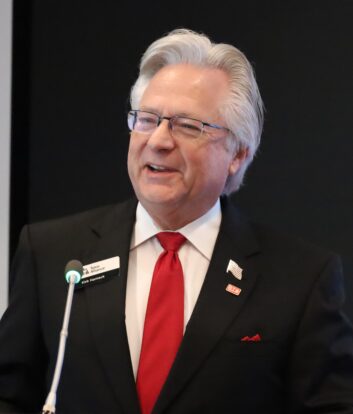
“We can now even do all audio console functions on a generic computing device and control it via a user interface,” he said, adding that other elements of a broadcast chain, such as playout devices, processors and talk show systems, can be virtualized.
Harnack observed that “containerization” has now entered the broadcast arena, explaining that a container amounts to a software package with all necessary elements for running in any computing environment. With such technology, the operating system is itself virtualized, allowing the container to run on platforms ranging from a laptop to the cloud.
“Instead of virtualizing the whole machine, we share the operating system with ‘buckets’ or ‘containers’ that hold the one application in isolation, but allow it to share the resources of the platform,” said Harnack.
“It’s a matter of ‘containers’ versus virtual machines (VMs). The container achieves the same goal as a VM, but you don’t need to buy another physical computer.”
WHEN TO REBUILD? WHEN TO REPLACE?
Shared transmission sites have been part of the broadcasting landscape for quite a while, and some now are candidates for refurbishment or possibly replacement. Dielectric’s Nicole Starrett and American Tower’s Dan Glavin examined considerations involved in updating sites in their presentation “Retrofitting Community Transmission Systems, Supporting Legacy Broadcast Systems.”
They explained that a shared or “community” transmitter site provides several advantages, including reduced construction/operating costs and better coverage, but time can take its toll on antennas, transmission lines and combining systems. Complicating this is that some equipment manufacturers are no longer in business, making it difficult to obtain replacement parts.
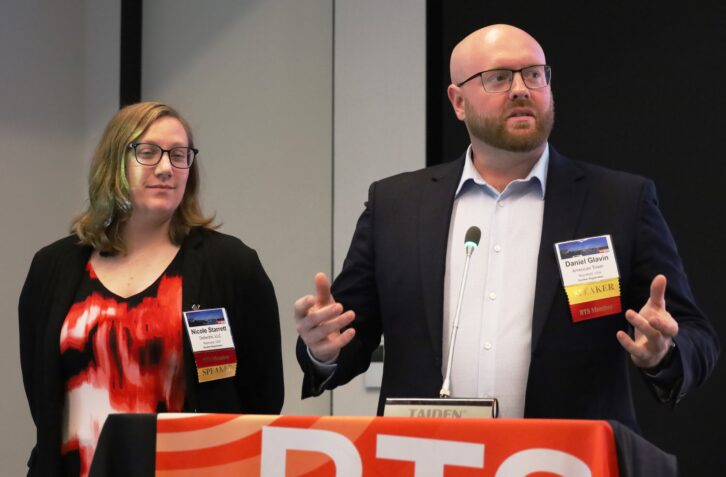
While it might be cheaper to keep some legacy systems in operation, full replacement could be in order in certain situations.
“If the existing baseband system is no longer needed, with only single channel or dual channels left, replacement is cleaner and more cost-effective over retrofitting,” said Starrett.
Other incentives for replacement include systems unable to meet new bandwidth and coverage requirements, as well as those with recurring outages caused by aging components.
In concluding their presentation, they observed that “retrofitting and reconfiguration are great options with many systems, expansion with software-developed solution is possible in some cases and a full replacement may not be necessary. However, if a full replacement is mandated, new technology can provide better performance, lower antenna/tower wind loading, and can be more cost-effective in the long run.”
ADDING RADIO TO NEXT-GEN TV
In moving away from the older ATSC 1.0 DTV standard, architects of the latest standard, ATSC 3.0 or “NextGen-TV,” made sure it would be futureproof, allowing new features to be added as needed.
Building on this concept, S. Merrill Weiss, principal at the Merrill Weiss Group, described incorporation of a digital radio service to ATSC 3.0 television transmissions.
In his presentation “Integrating Radio Services With Television and Data Transmission on the ATSC 3.0 Platform,” Weiss said the motivation for this came from countries now interested in ATSC 3.0 that wanted it to include digital radio services. The Digital Radio Mondiale standard was selected, as it’s being used in those countries.
Weiss said that in addition to stereo and mono audio, the project involved addition of advanced text-based services, icons and other graphics, along with and support for a service selection guide.
As explained by Weiss, integration of DRM with ATSC 3.0 involves incorporation of a “radio gateway,” along with other additions and changes, and that the DRM implementation could provide a large number of audio services and Journaline text services.
Weiss noted that the DRM addition would require addition of documents to the ATSC standards list involving its A/330 link layer protocols and A/324 scheduler and studio-to-transmitter protocols. Also, “two new standards need to be created, one for the radio gateway, and another to (describe) recommended practices for ATSC 3.0 radio.”
USING SRT TO OVERCOME A C-BAND SPECTRUM ISSUE
RF spectrum for broadcast use keeps shrinking, and Guy Bouchard, formerly with Canada’s Télé-Québec public broadcasting operation and now a consultant, described a solution to problems created by reassignment of C-Band satellite spectrum to wireless carriers.
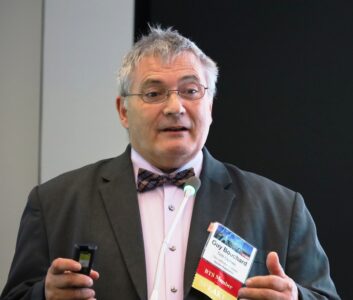
Bouchard explained that while only a relatively small percentage of the Télé-Québec ‘s audience receives programming over-the-air, it’s necessary to maintain this service, which is provided by 18 transmitter sites linked to the ops center via satellite.
“Two-thirds of those transmitters are in remote locations without access to fiber or high-speed internet connectivity,” said Bouchard, explaining that all had 4.5-meter dishes, with the original design providing a 4 to 6 dB link margin, but the addition of the 5G filtering ahead of the LNBs reduced gain, effectively reducing dish aperture.
He said although the reduced margin doesn’t impair signal delivery in good weather, a snowfall can severely degrade reception.
Due to the small terrestrial broadcast audience, the expense of installing larger antennas couldn’t be justified, so another solution was needed. This came in the form of Secure Reliable Transport protocol, which utilizes advanced error correction to enable uninterrupted data flow over less-than-perfect Internet paths.
Bouchard said he was skeptical at first about SRT’s ability to deliver programming reliably to transmitter sites, but test results proved otherwise.
“In the initial trial, no artifacts were reported and no alarms were received.”
He said that the SRT-enabled terrestrial delivery is now only being used to back up satellite delivery, with no plans currently to discontinue satellite linkage, but that could change in the future.






